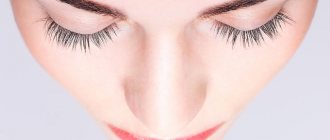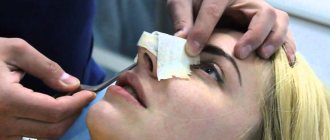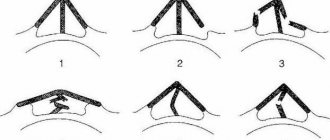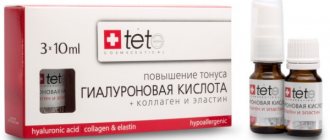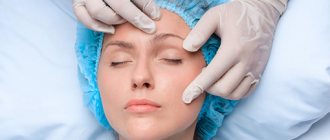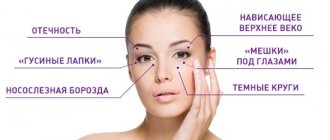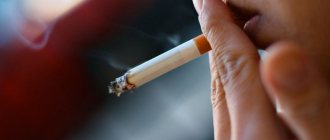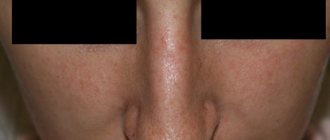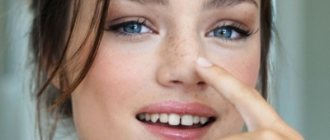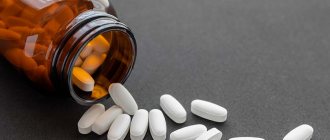Despite the frequency of such an operation, changing the nose requires skill from the surgeon and patience in compliance with the rules of postoperative recovery from the patient.
There are quite a few prohibitions, but they are all important.
Alcoholic drinks can only be consumed after changing the shape of the nose after six months. Although, some doctors allow you to drink a little wine after a month.
Recommendations before rhinoplasty
First of all, a month before the operation, you need to give up bad habits such as smoking and alcohol. They can negatively affect the immune system and affect blood circulation, which nourishes the tissues. During surgery and during the recovery period, you will need your immunity more than ever. Smoking negatively affects blood vessels, increasing pressure, which can lead to the formation of blood clots in the capillaries. The supply of oxygen to tissues is disrupted, which can lead to necrosis. Therefore, the question of whether you can smoke before and after rhinoplasty is absolutely obvious. Habits such as smoking hookah, e-cigarettes, chewing gum and nicotine patches should also be eliminated.
Important! Rhinoplasty is not only a reason to radically change your appearance, but also a real opportunity to quit smoking forever.
Alcohol after rhinoplasty
Alcohol must be avoided not only before surgery, but also after. Most often, after rhinoplasty, the doctor prescribes antibiotics. And these drugs, as has long been known, cannot be combined with alcohol, which can significantly reduce the effect of using the drugs. Plus, during alcohol intoxication, a person loses vigilance, and unpleasant injuries are possible, which can lead to revision rhinoplasty. Therefore, doctors recommend giving up strong alcoholic drinks for six months.
Recovery after surgery
The rehabilitation period after rhinoplasty reaches several months. During this period of time, it is necessary to carefully and carefully follow all the recommendations of the attending physician. Normal nasal breathing will be restored only after a few days. After rhinoplasty, turundas are inserted into the nasal passages, which will help avoid nasal deformation and absorb excess fluid. This is an unpleasant but necessary measure to avoid complications during the rehabilitation period.
Important! Under no circumstances try to remove the bandage yourself or remove the turundas from the nose, this is guaranteed to cause complications and complicate recovery.
Immediately after the operation, you will most likely have a headache, but this is a common consequence of the procedure, which your doctor should warn you about. You will also feel the “heaviness” of your face, which is also a normal effect. The voice after rhinoplasty will be unusually nasal, this will last from a week to two. If there are no complications, the turundas can be removed after three days, however, due to swelling, nasal breathing will not yet be fully restored.
The cast after rhinoplasty is removed after about 10 days. But even after this, the appearance will be far from ideal. After the operation using the open method, the stitches will still be visible, and the swelling will persist for up to six months.
Do not touch the stitches, otherwise the wound may become infected. Only the doctor has the right to remove the medical thread!
Proper facial care
High-quality facial skin care is very important both before and after nose surgery. A feature of the recovery period is the fact that the skin is under plaster for a certain period of time, where there is no way to clean it. In addition, after rhinoplasty, all areas of the face are treated with various antiseptics, which have a negative effect on it with prolonged use. After frequent application of antiseptics, the skin begins to peel off.
Why can our articles be trusted?
We make health information clear, accessible and relevant.
- All articles are checked by practicing doctors.
- We take scientific literature and the latest research as a basis.
- We publish detailed articles that answer all questions.
After surgery, an inflammatory process may occur on the skin of the face, which is expressed in the presence of acne, increased oiliness of the skin, and areas of flaky skin.
According to doctors' recommendations, you should not be afraid to touch your face, wash it every day, and gently wipe it with a hard towel. This procedure removes flaky skin and eliminates harmful bacteria.
After removing the plaster from the nose, it is recommended to wash your face with special scrubs designed to cleanse the pores of the skin. They must be applied by rubbing and then rinsing with a small amount of water.
Rhinoseptoplasty
Rhinoseptoplasty is a type of surgical intervention, the essence of which is to correct a deviated nasal septum, as well as change the shape and appearance of the nose.
When purchasing such products, you need to familiarize yourself with their composition and intended effect, since warming or cooling scrubs are not suitable for cleansing the skin after rhinoplasty.
There is a technology for rinsing the nose after rhinoplasty:
- Your head should be tilted to the side, over the sink.
- Inhale your breath for a few seconds.
- Apply a pipette with a rinse to the nostril and rinse it.
- After that, you need to blow off the contents remaining in it from the nostril. This is done carefully, blowing air out of the nostril with a slight movement, opening the mouth slightly and at the same time lightly pinching the other nostril with the tip of the finger.
- Rinse in the same way .
Most often, doctors recommend washing with seawater-based products. This procedure is required starting 3 or 4 days after surgery after removing tampons from the nose, with a frequency of 2-3 times a day for 1 month. After rinsing the nostrils, it becomes easier for a person to breathe, and the rehabilitation process is much easier.
Personal hygiene
After surgery, for facial hygiene, it is necessary to use cleansing tonics and lotions, which are applied with clean sponges. All movements are made smoothly and accurately, without touching the nose area. Regular facial cleansers can be used three months after rhinoplasty.
For washing, you should use only water at room temperature, avoid contrasting water procedures, which can adversely affect the skin restoration process. In order not to wet the splint on your nose when you wash your hair, it is better to ask your loved ones for help.
Note! The first two weeks after rhinoplasty, you should give preference to loose-fitting clothes, with buttons or zippers, so as not to injure yourself when removing them over your head.
Can you sleep on your side after rhinoplasty?
Regarding sleep during the rehabilitation period, there are also certain requirements. To avoid deformation of the plaster, it is strictly prohibited to sleep on your side in the first month after rhinoplasty. You need to sleep on your back with your head elevated on the pillow. Or, if you have an orthopedic bed, raise the head of the bed. This position while sleeping will reduce swelling of the face and speed up the healing period. If you like to sleep with your face in the pillow, you need to wait until six months, when the rehabilitation period comes to an end.
General tips for post-operative rehabilitation
Nose correction
There are a lot of plastic surgeries performed. One of the popular areas of facial correction is the nose. The success of the procedure depends not only on the hands of the plastic surgeon, but also on the patient’s compliance with the rules during the recovery period. Rehabilitation also implies adherence to the necessary prohibitions. Alcohol after rhinoplasty is an absolute contraindication.
Rhinoplasty, despite its popularity, is a rather serious surgical procedure. The recovery period is slow and until the final result, your nose and well-being will change several times.
After anesthesia
As soon as the patient wakes up after anesthesia, his first sensations are weakness, drowsiness, and nausea.
Such side effects appear after anesthetics. Once they are eliminated from the body, the symptoms will go away. After the operation is completed, turundas are inserted into the patient’s nose, and a plaster or plastic bandage is applied to the sniffing organ itself. Therefore, it will not be possible to see what this area looks like immediately after surgery.
Important! It is strictly forbidden to remove the plaster cast and cotton pads on your own.
It is not even recommended to use clothes that you have to put on over your head, especially with a narrow collar.
Appearance after surgery
But, if you look at the face, it is already noticeable that the intervention was serious. The eyelids and nose area all look swollen with bruises. Even the cheeks can be affected. After a week, the fluid will decrease and the patient will look like himself.
Rehabilitation by day
It is divided into several stages and contains the following points.
First two days
- The patient experiences pain, so he is forced to take painkillers as prescribed by the doctor.
- A course of antibiotics is required to eliminate the risk of infection.
- For the first few days, a person is forced to walk with hemostatic turundas that absorb secretions.
- The patient is forced to breathe through his mouth until the turundas are removed.
- When the old turundas are removed, the mucous membrane is treated with special means for speedy rehabilitation, then new ones are inserted. Contrary to misconceptions, the procedure for removing turundas is completely painless.
First 7 days
The patient is recommended to lie more on his back.
In 2 weeks
The sutures are removed, and the cast or fixing bandage is removed. The itching and irritation caused by the plaster goes away. The main thing is to endure this period and not remove the bandage yourself, so as not to deform the still unhealed nose and spoil the result of rhinoplasty. If everything went well, then on day 10 the plaster itself may fall off. In this case, you should definitely contact a surgeon.
When the tampons are removed, there are still stitches in the nostrils and in the folds of the wings of the nose. You cannot pull them with tweezers, otherwise the seams may come apart and remain as unsightly scars. During this period, it is not recommended to actively show facial expressions and laugh; lip movements can also affect the course of recovery. In the first two weeks the voice is nasal, but this goes away over time.
The duration and severity of recovery depends on the extent of surgical intervention. The wider the area of damage, the greater the discomfort. If the correction was carried out on the tip of the nose, then rehabilitation will take place quickly, within a week, with minimal swelling, unlike plastic surgery of the bridge of the nose.
After a 2 week break after rhinoplasty
The next stage of recovery lasts 2 weeks after surgery and 2.5 months. It is not as difficult as the postoperative period. The stitches have already been removed and the splint is missing. Discomfort occurs when breathing, which cannot yet be fully nasal due to long-term swelling. The bruises have not yet gone away, but the outlines of the nose are already visible. Although, it will still be approximately 2 times larger than planned due to swelling, which can remain in the nose area for up to 6 months. The final version of the nose is far from complete, because in 3 months only 50% of the swelling will go away. Therefore, you will have to wait about 1 year.
At the end of the first month after rhinoplasty, you can go out in public and not hide, fearing for the appearance of your face. The size of the nose will change over several months, improving in shape.
Final period
Starting from the third postoperative month, final rehabilitation begins. During this period, the swelling goes away completely, the nose becomes normal in shape and size. With a successful operation, the imperfections that cause discomfort should go away. If the surgeon made a mistake, the effect will be the opposite. At this stage, you can summarize the operation and determine whether it was successful or not.
Sports after rhinoplasty
After the operation, it is worth reconsidering the nature of your movements; they should be as smooth as possible. Try not to bend over, this can cause the stitches to move and even bleed. Sports will have to be limited for 2-3 months. During active movements during sports, the heartbeat increases and, accordingly, blood circulation. Professional athletes should give up intense training for six months. If you practice martial arts, rhinoplasty is recommended after finishing this sport, otherwise serious injuries are possible. Doctors recommend walking in the fresh air. Do not lift heavy objects, children or animals. When cleaning your home, avoid mopping the floors. If possible, shift this responsibility to house helpers or relatives.
Emotions after surgery
After rhinoplasty of the wings and tip of the nose, doctors strongly recommend restraining emotions. This process can cause the surgical sutures to come apart, which in turn causes scarring.
Even sneezing must be done with extreme caution. It is worth avoiding upper respiratory tract diseases as much as possible, as they can lead to unwanted nose blowing and sneezing.
In case of illness, cotton swabs can come to your aid to help gently clean the nasal passages. You can allow yourself to blow your nose only a month and a half after rhinoplasty, in the absence of complications.
Advice! If you can't stop sneezing, do it with your mouth open. In this case, the pressure on the vessels and sutures will be less.
Rhinoplasty and pregnancy
It will take at least a year for the body to recover after surgery. Therefore, pregnancy planning should be postponed for this period. In a year, the body will be able to endure global restructuring and the load that a woman will face during childbirth. If you plan to have rhinoplasty after childbirth, you must wait until the end of the breastfeeding period. Be sure to take into account all of the above recommendations that should be followed after surgery.
Note! If you have a small child, you will need mandatory assistance in caring for him. After all, during the rehabilitation period after rhinoplasty there are a lot of restrictions.
Diet after
Surgical intervention is a factor of additional burden on the body in the form of stress, after which the tissues require restoration of the supply of vitamins, minerals and other nutrients.
The rehabilitation period involves a temporary restriction in certain foods and a specialized diet that must be followed for 2 months.
You can eat food 5-6 times during the day, but in small portions. In small volumes, food entering the body will be absorbed faster.
You can't eat:
- roast;
- salty;
- smoked;
- spicy;
- pickled;
- pasta;
- sweets;
- from meat - lamb, pork, goose meat.
Plastic surgery of a hump on the nose
In some cases, a hump makes it difficult to breathe, leading to more serious problems, so hump rhinoplasty is recommended in such cases.
All dishes that are prepared at home should be steamed or boiled; to make cooking easier, you can use a double boiler.
You can and even should eat:
- meat without fat - chicken, beef, turkey;
- lean fish;
- fermented milk products ;
- from cereals - oatmeal, pearl barley and buckwheat (no more than 200 grams);
- vegetables in unlimited quantities - tomatoes, cucumbers, radishes, zucchini;
- figs, apricots, dried apricots;
- crackers, rye bread;
- from liquids - green tea, compote, fruit drink, jelly.
The volume of water consumed per day should be at least 2 liters, thus speeding up metabolism and food is digested much faster. Following such a diet during the first 2 months after plastic surgery helps to normalize metabolic processes in the body, protects it from excessive stress and stress, and does not cause swelling.
All norms of a rational diet must additionally be explained to the patient by a surgeon who is interested in the speedy appearance of the result of a successful operation.
How to rinse your nose after rhinoplasty
The procedure for rinsing the nose is necessary, even if this is an unusual thing for you. Cleansing the intranasal passages will moisturize the mucous membrane, relieve inflammation and swelling. In addition, rinsing is beneficial for blood vessels and allows for faster healing, which will allow you to breathe easier.
Note! The procedure can only be prescribed by your attending physician. Do not engage in amateur activities as this may result in injury.
The doctor will give you recommendations on how to correctly perform the procedure and what products to use. Often, during the rehabilitation period, nasal rinsing with special salt preparations is prescribed, which help restore balance in the nasal passage. The procedure is carried out several times a day for a month until breathing returns to normal.
What not to do
In order for a new nose to heal quickly, it should be protected from various negative factors. Be sure to exclude:
- - consuming large amounts of salt , which provokes pain and swelling. This also includes smoking. It is not recommended to consume ice-cold and hot food and drinks for 3 weeks;
- — Alcohol is strictly not recommended;
- playing sports to avoid mechanical damage to the nose. The tissues after surgery are very fragile and can be damaged even after heavy lifting. In addition, it is not recommended to even tilt your head forward while the turundas are standing. Women should not lift children or pets. Visiting the gym is allowed after 3 months. Professional sports are banned for six months;- - overheating so as not to interfere with bones, cartilage and skin growing together. Sauna, steam bath, solarium and open sun are not recommended for 3 months. Even hot baths are prohibited. You can only take a warm shower, but while the splint or cast is in place, you cannot get your head wet. If you stay in the sun for a long time and do not use protection, you can get hyperpigmentation;
- - freezing , as vasospasm may occur and serve as an obstacle to tissue regeneration;
- - exercises in the pool and in open water for two months to prevent infection. In addition, you need to be wary of colds, which when swimming increases the likelihood of their occurrence;
- - use of glasses , since even the lightest frames can lead to deformation of the nose due to pressure on the bridge of the nose and possible pain;
- - nasal rinsing , carried out after removing the plaster on the recommendation of a doctor. To do this, you need to tilt your head slightly to the side, use a special pipette to pour the medicine into the nostril opposite the side of the tilt, blow your nose, drip peach oil and treat the mucous membrane with ointment;
- — applying cosmetics for at least 14 days. At the same time, you can’t wash your face at all for the first days. Firstly, because of the plaster, which is not allowed to get wet, and secondly, because of the downward tilt of the head. Washing can be done with cleansing tonics or micellar water until the doctor removes the cast;
- - lying on your side and stomach so as not to injure your nose. It is better to sleep on a firm, high pillow or in a semi-sitting position on a special bed with a raised headboard. This period should last at least 20 days, after which you can carefully turn on your side. Full sleep is allowed after six months;
In general, it is not advisable to even touch your nose, not to mention tearing off the crusts inside, so as not to provoke additional bleeding.
How to properly clean your nose after rhinoplasty
- Tilt your head to the side over the sink and use a pipette to pour the required amount of saline solution into your nostril.
- Opening your mouth, lightly blow the contents out of your nostrils, blowing your nose. The nostril should be covered with your finger. Do not press or press on your nose under any circumstances to avoid injury.
- Upon completion of rinsing, it is worth lubricating the nasal passages with a special ointment or emollient oils: sea buckthorn, peach, apricot. An ointment or other care product should be selected by the attending physician.
Hair washing procedure after
After a nose job, you should not take a hot shower; to avoid high temperatures, you should only use warm water when washing your body and head.
The method of washing your hair without outside help will be difficult, since during this procedure you should not allow your nose to tilt forward.
If you do not maintain the correct body position when washing your hair, you can get a deformation of your nose that has not yet healed. It must be carried out as in a hairdresser, throwing your head back so that the hair flows down over the sink or bathtub, and the position of the nose remains unchanged.
conclusions
The recovery process after rhinoplasty varies from person to person. Therefore, you should focus on your own feelings, and be sure to listen to the recommendations of your doctor.
Only an experienced plastic surgeon can guarantee a high-quality result of rhinoplasty and the most painless rehabilitation period.
Feel free to ask all the questions that bother you. This way you will minimize your own experiences as much as possible, and correct real violations after the operation in time. In the postoperative period, subject to full compliance with all the surgeon’s recommendations, responsibility falls entirely on the shoulders of the patient. Today, cases of doctor error during surgery are rare. In this case, revision rhinoplasty may be required, in the same or another clinic. In addition, we invite you to read reviews from those who underwent surgery and photos of recovery after rhinoplasty.
Duration of the recovery period
It is difficult to say how long it will take for the body to fully recover. This is influenced by several factors:
- Complexity of the operation . If the correction was minimal, the nasal tissue will heal quickly. When bones and cartilage change, rehabilitation can last up to 1 year.
- Feature of the organism . Some people have soft cartilage, others have hard cartilage, just like their skin is soft or thick. This affects the rate of cell and tissue recovery, as well as the regeneration process itself.
- Following your doctor's advice . It is important to follow the rules of the recovery period.
- Features of access to the correction site . With the open method, additional time will be required to smooth the seams.
Taking into account all the nuances, recovery can take from 4 to 12 months. Compliance with the conditions of the rehabilitation period is important.
Reviews about rehabilitation after rhinoplasty
Egor, 27 years old Since childhood, I have had a rather peculiar nose, wide and fleshy. Most of the inconvenience came from my wings, which I had wanted to remove since I was a teenager. After I turned 20, I began to wonder whether a man should undergo rhinoplasty, since I believed that it was mostly done by women. But my nose began to cause more and more discomfort, and I made up my mind. I decided to have rhinoplasty done in Moscow, since objectively there are the best specialists here. The procedure was easy, I was more afraid of rehabilitation and complications. The doctor was competent and told me what and how. I recovered for four months. For the first month, my face was completely swollen and I didn’t leave the house. Then the swelling began to slowly go away, and the nose began to take on a new shape.
